Tribute: Hank Williams

Hank Williams was country music royalty, a music legend, and an American icon. His distinctive voice and ability to convey raw emotion through his songs has allowed his work to endure over half a century. His songs are numerous, his accolades are many, but his years on this earth were few. This is the story of Hank Williams, accompanied by a listing of his number one hits, an inventory of his awards, and the eerie story of Hank's emotion reaching from beyond the grave.
Hiram King Williams was born on 17 September 1923, in a log cabin in Mount Olive, Alabama, to Elonzo Huble Williams ("Lon") and Jessie Lillybelle Skipper ("Lillie"). He was named Hiram, but his name was misspelled "Hiriam" on his birth certificate. Hank was born with spina bifida, a birth defect resulting in an incompletely formed spinal cord. The vertebrae overlying the open portion of the spinal cord also do not fully form and remained open allowing the abnormal portion of the spinal cord to stick out through the bones, resulting in chronic pain. It is suggested that this was a motivating factor in Williams' later abuse of alcohol and drugs.

In July, 1937, Williams decided to permanently go by "Hank" and not "Hiram." Williams sang and played his guitar in front of the WSFA radio studios (Montgomery). He quickly caught the attention of the producers, who occasionally invited him to perform on air. So many listeners contacted the radio station asking for more of the "Singing Kid" that he was hired to host his own fifteen-minute show, twice a week for fifteen dollars.
At this time, Williams started his own band, the Drifting Cowboys. They traveled throughout central and southern Alabama, and eventually as far away as Georgia and Florida. Yet Hank continually returned to Montgomery to host his radio show. Unfortunately, Williams's dependence on alcohol worsened, and he often arrived at the show inebriated. In August 1942, WSFA fired him due to "habitual drunkenness."
In 1943, Hank met Audrey Shepard, who became his manager. In 1944, they married. In 1946, Williams recorded two singles - "Never Again" and "Honky Tonkin'" - which were successful. Williams signed with MGM Records, and released "Move It On Over," a huge country hit. In August 1948, Williams joined The Louisiana Hayride, increasing his notoriety and popularity. Hank released his version of Rex Griffin's "Lovesick Blues" in 1949, which became another country hit and crossed over to mainstream audiences. Hank sang "Lovesick Blues" at the Grand Ole Opry, where he became the first performer to receive six encores. Hank released seven hit songs that year, including "Wedding Bells", "Mind Your Own Business", "You're Gonna Change (Or I'm Gonna Leave)" and "My Bucket's Got a Hole in It". Also in 1949, Audrey gave birth to Randall Hank Williams (Hank Williams, Jr.).
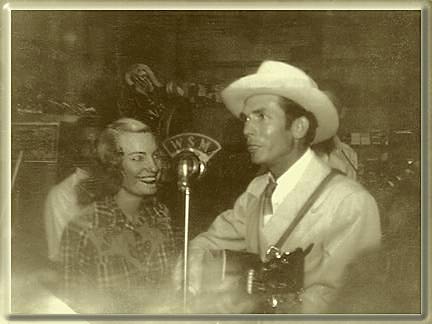
Hank and Audrey Williams, from the Rockabilly Hall of Fame Scrapbook.
In 1950, Williams began releasing religious recordings under the name "Luke the Drifter." He feared his fans may reject him if they did not accept this new religious direction, so he hid his identity. But he continued to release secular radio hits as Hank Williams.
Williams' marriage was rapidly deteriorating, and his problems with alcohol, morphine and other painkillers increased. (The painkillers were prescribed to ease his back pain caused by the spina bifida.) Williams and Audrey divorced in May 1952. A relationship with Bobbie Jett during this period would result in a daughter, Jett.
In August 1952, Williams was fired from the Grand Ole Opry, again for frequent drunkenness. So he rejoined the Louisiana Hayride. In October 1952, he married Billie Jean Jones. A ceremony was held at the Shreveport Municipal Auditorium (Louisiana) and 14,000 people bought tickets to attend. Soon after, the Drifting Cowboys decided to continue without Williams. Hank was supposedly drinking more than a show would pay. He was now taking morphine and the sedative chloral hydrate in addition to the alcohol.
On 1 January 1953, Williams was due to play in Canton, Ohio, but he was unable to fly because of foul weather. He had just finished a performance at the Skyline Club in Austin, Texas. Hank hired a chauffeur for a Cadillac and, before leaving the old Andrew Johnson Hotel in Knoxville, Tennessee, was injected with B12 and morphine. When the chauffeur, 17-year-old Charles Carr, pulled over at an all-night service station in Oak Hill, West Virginia, he discovered that Williams was unresponsive and becoming rigid. Hank was dead at the age of 29. Cause of death was a severe heart attack caused by excessive drug and alcohol consumption. View his death certificate. This is a photo of Hank in his casket.
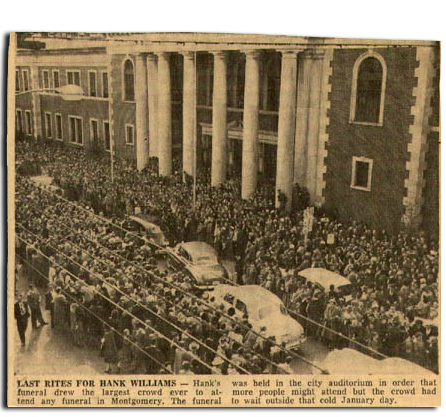
Funeral processsion of Hank Williams. Photo from The Archive of the Death of Hank Williams.
Williams' final single was ominously titled "I'll Never Get Out of This World Alive". His funeral was said to have been larger than any ever held for a citizen of Alabama and the largest ever held in Montgomery. Twenty thousand people attended. He is interred in Oakwood Annex in Montgomery, Alabama, next to his first wife, Audrey.
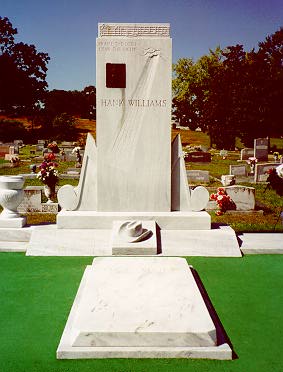
Five days after his death, his daughter by Bobbie Jett, Antha Belle Jett, was born. She was adopted by Hank Williams' mother, Lillie, in December 1954 and re-named Catherine Yvonne Stone. Lillie died in 1955, and the girl was made a ward of the state of Alabama and subsequently adopted by new parents who renamed her Cathy Louise Deupree. It wasn't until the early 1980s that she learned who her biological parents were. Although Hank Williams had executed a pre-birth custody agreement three months before her birth that gave him custody of his unborn daughter, she was forced to go to extreme lengths to be recognized as Hank's daughter. In 1985, the Alabama State Court ruled that she was the daughter of Hank Williams. In 1987, the Supreme Court of Alabama ruled that she was entitled to her half-share in Hank's estate, as she had been the victim of fraud and judicial error. She changed her name to Jett Williams.
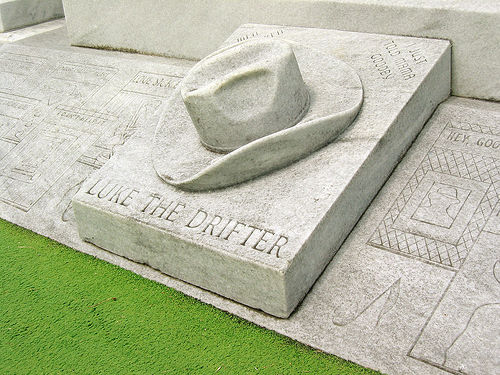
The Curse of Hank Williams?
Hank Williams died 1 January 1953. In September of that same year, his second wife and widow, Billie Jean Jones, married another country musician, Johnny Horton. Horton was famous for his songs, "Sink the Bismarck," "North to Alaska," and "The Battle of New Orleans" (which won a Grammy and other accolades). In 1960, Horton was killed when a drunk driver hit his Cadillac head-on in Milano, Texas. Horton had been returning home on Highway 79 from a performance at the Skyline Club in Austin.
What's the significance?
Horton married Williams' widow a mere six months after Hank's death. Horton was killed by a drunk driver; Williams' death was a result of his alcohol and drug abuse. (It's not a stretch to presume that Williams was drunk when he died.) Both Horton and Williams played their last shows at the Skyline Club and both died in Cadillacs. In 1953, Horton was returning from a performance when he had heard on the radio about the death of Hank Williams. Horton was on Highway 79 going through the town of Milano, Texas - the same road and town where he would have his fatal accident seven years later.
- Hank Williams' Number One Singles
- "Lovesick Blues" (1949)
- "Long Gone Lonesome Blues" (1950)
- "Why Don't You Love Me?" (1950)
- "Moanin' the Blues" (1950)
- "Cold, Cold Heart" (1951)
- "Hey Good Lookin'" (1951)
- "Jambalaya (On the Bayou)" (1952)
- "I'll Never Get Out of This World Alive" (1952)
- "Kaw-Liga" (1953)*
- "Your Cheatin' Heart" (1953) *
- "Take These Chains from My Heart" (1953)*
-
*Posthoumous releases
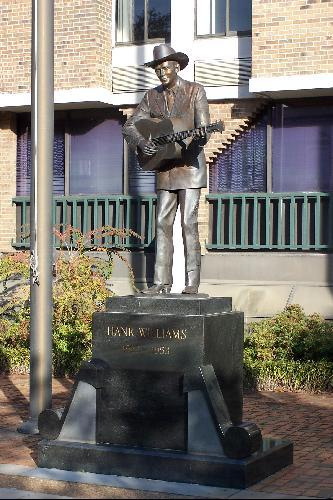
Life-sized statue of Williams erected in downtown Montgomery, Alabama.
- 1961
- First artist inducted into the Country Music Hall of Fame.
- 1969
- Country Music Hall of Fame inducted him into the Walkway of Stars.
- 1970
- Inducted into the Songwriters Hall of Fame.
- 1983
- Grammy Hall of Fame Award, "Your Cheatin' Heart"
- 1985
- Alabama Music Hall of Fame inductee.
- 1987
- Inducted into the Rock & Roll Hall of Fame.
- 1989
- Grammy for Best Country Vocal Collaboration with Hank Williams, Jr.
- Country Music Association Music Video of the Year with Hank Williams, Jr. for "There's a Tear in My Beer."
- Country Music Association Vocal Event of the Year with Hank Williams, Jr. for "There's a Tear in My Beer."
- Academy of Country Music Video of the Year with Hank Williams, Jr. for "There's a Tear in My Beer."
- 1990
- TNN/Music City News Vocal Collaboration of the Year with Hank Williams, Jr.
- TNN/Music City News Video of the Year with Hank Williams, Jr.
- 1993
- Featured on a United States postage stamp.
- 1994
- Ranked Number One on Life Magazine's list of "The 100 Most Important People in Country Music."
- 1996
- A bridge was built in Spainshburg, West Virginia on Route 19, replacing the one which Williams's car passed over on 1 January 1953. It was renamed the Hank Williams Sr. Memorial Bridge.
- 1999
- Third inductee into the Native American Music Hall of Fame. Williams was part Muskogee Creek and Tsalagi (Cherokee). (Jimi Hendrix and Buddy Red Bow were numbers 1 and 2, respectively.)
- Grammy Hall of Fame Award, "I'm So Lonesome I Could Cry."
- 2001
- Grammy Hall of Fame Award, "Hey Good Lookin'."
- 2002
- Grammy Hall of Fame Award, "Jambalaya."
- 2003
- Country Music Television ranked him #2 of the 40 Greatest Men of Country Music. (Top honors went to Johnny Cash.)
- 2010
- Special citation by the Pulitzer Prize Committee for "his craftsmanship as a songwriter who expressed universal feelings with poignant simplicity and played a pivotal role in transforming country music into a major musical and cultural force in American life."
- Other honors:
- Inducted into the Nashville Songwriters Hall of Fame.
- Voted the 74th Greatest Rock 'n' Roll Artist of all time by Rolling Stone magazine.
- Statue erected in Montgomery, Alabama (photo, above).
Awards
For additional information and great photos relating to the death of Hank Williams, visit the Archive of the Death of Hank Williams.